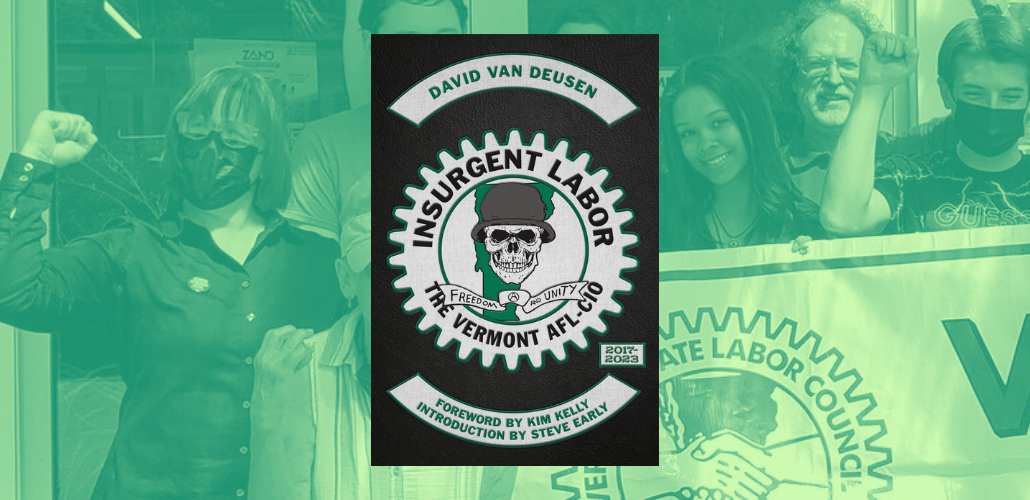Review: How Reformers Doubled Vermont AFL-CIO Membership

Insurgent Labor: The Vermont AFL-CIO, 2017-2023, by David Van Deusen (PM Press, 2024)
Photo: Vermont AFL-CIO
Transforming an existing union into a more democratic and member-run organization has often proven to be a daunting—though possible—task. The pressing need to revitalize organized labor in the U.S., however, depends on such movements.
Beginning in 2017, a slate of reform-minded union activists won leadership offices in the Vermont state federation of labor, reinvigorating that organization. Within just a few years, the federation’s membership doubled.
Insurgent Labor: The Vermont AFL-CIO, 2017-2023 is two-term president David Van Deusen’s participant-retelling of the emergence of the UNITED reform group. As a model for revitalizing labor, this story contains quite a lot of inspirational and thought-provoking material that working-class activists will find beneficial.
In his introduction, longtime labor journalist Steve Early makes a persuasive argument that this story follows in the tradition of rank-and-file insurgencies like Miners for Democracy and Teamsters for a Democratic Union.
REFRESHINGLY FRANK
One of the reasons this account is both fascinating and potentially useful is that Van Deusen is not only uncompromisingly radical in his commitment, but also refreshingly frank.
He appraises the obstacles and mistakes that he and his fellow insurgents encountered as they set out to transform an entire state-level AFL-CIO organization, putting it on a road to playing a role in both workplace and community struggles as well as boosting member involvement and numbers.
These obstacles included not only an entrenched old guard at the local level, but also pushback from the national AFL-CIO when the insurgents undertook plans for a general strike if an anticipated coup had occurred in the wake of the 2020 presidential election.
A threatened imposition of receivership—like the coup and strike—never materialized, thanks in part to the mobilization of an extensive network of allies.
CLOSE TO THE SHOP FLOOR
Key to the success of the UNITED reformers was their continual communication with workers at the shop floor, a time-consuming procedure given the mix of unions affiliated with the state federation. His account of working with the grassroots membership to build and maintain a reform caucus more closely resembles the duties of skilled shop stewards than the maneuvers of power brokers.

SUPPORT LABOR NOTES
BECOME A MONTHLY DONOR
Give $10 a month or more and get our "Fight the Boss, Build the Union" T-shirt.
One of the most important innovations the reformers brought was a willingness to commit effort and resources to the organizing efforts of various unions—whether or not they were affiliated with the federation—and even to community groups. This expansive outreach and sense of solidarity forged valuable alliances and increased the number and size of unions that chose to affiliate.
Within the federation, as in any democracy, debates over tactics and positions are inevitable. Van Deusen is forthright about the times when he was outvoted by his fellow insurgents—or committed himself to a course of action that turned out to be a tactical error.
Though he’s a committed leftist, he’s also refreshingly untainted by the sort of factional groupthink into which so much of the New Left degenerated in the aftermath of the 1960s.
AN ANTIDOTE TO CYNICISM
Activists who know about labor’s early roots in organizations like the Industrial Workers of the World have long been somewhat dismissive of conventional unions as vehicles for genuine social transformation—viewing the mainstream movement as an “American fragmentation of labor” rather than a means of empowering workers.
Van Deusen doesn’t gloss over the shortcomings of organized labor since the ascendancy of business unionism from the middle of the last century. This book, nevertheless, is a welcome antidote to such entrenched cynicism. It’s a good reminder of the need to combine, in the words of the great Marxist intellectual Antonio Gramsci, pessimism of the mind with optimism of the will.
His firsthand account of the resurrection of the Vermont state federation from bureaucratic slumber and irrelevance may not be easily replicated across the labor movement. Vermont is a very small state with a uniquely progressive history that also gave us Bernie Sanders.
But it meshes well with any number of recent developments, like the grassroots movement of West Virginia school strikes in 2018 and the newfound militancy among auto workers today. It may be time to notice which way the wind is blowing.
Gordon Simmons is chief steward of the West Virginia Public Workers Union and a member of the West Virginia Labor History Association.





